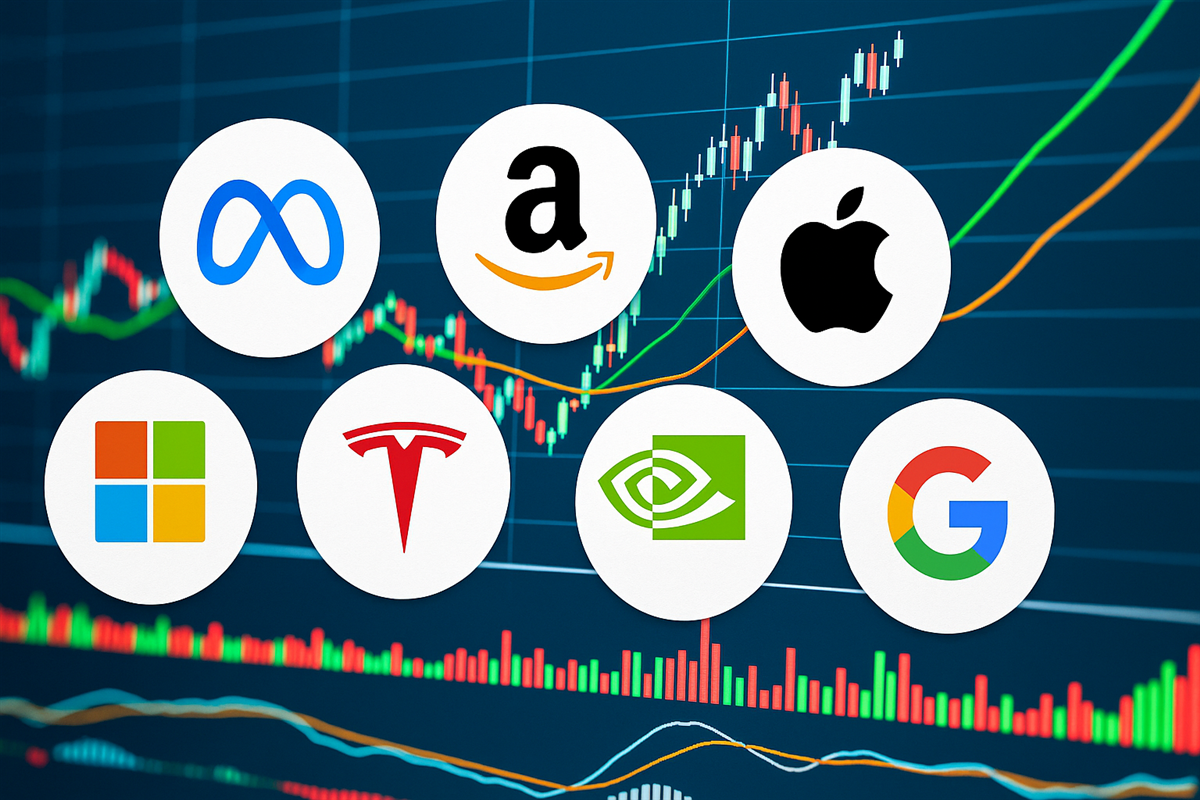|
|
|

|
|||||

|
|

This group, Microsoft Co. (NASDAQ: MSFT), Alphabet Inc. (NASDAQ: GOOGL) Meta Platforms Inc. (NASDAQ: META), Amazon.com Inc. (NASDAQ: AMZN), Apple Inc. (NASDAQ: AAPL), Tesla Inc. (NASDAQ: TSLA), and NVIDIA Co. (NASDAQ: NVDA), represents a blend of digital software giants, retail and cloud leaders, hardware innovators, and semiconductor powerhouses.
Together, they offer a window into the broader digital economy and investor psychology alike.
The comeback story starts with a recent bout of volatility that tested investor confidence. The announcement of new U.S. trade tariffs, dubbed “Liberation Day” by some, triggered a sharp market correction. Tech stocks, in particular, suffered as rising geopolitical and economic uncertainty led to a rush of selling, pushing many down by 20% or more from their 52-week highs. By definition, these declines marked a bear market phase for several of the Magnificent Seven.
This 20% drop threshold is more than just a psychological marker. It often triggers changes in margin requirements and risk exposure, prompting many institutional investors to reassess or rebalance portfolios. However, it also tends to act as a pivot point. A sharp rebound followed once the market absorbed the shock and capital stepped in to meet margin calls.
Now, the price action shows signs of resilience. Microsoft, for example, is trading at 96% of its 52-week high, a level few large-cap tech stocks have reclaimed so quickly. As a core software provider to enterprises and governments alike, Microsoft has emerged as a defensive play within the group. In contrast, Tesla remains under the 80% threshold — yet analysts see this as a sign of potential, not weakness.
One key theme in this rebound is divergence. Not all Magnificent Seven stocks are recovering at the same pace, which tells a broader story. Investors appear to be distinguishing between stability-driven leaders and high-volatility growth names.
Microsoft and Apple fall squarely into the former category. Their steady earnings, sticky customer bases, and diversified revenue streams make them attractive in a climate where safety is in vogue.
Alphabet and Meta offer similar defensiveness, bolstered by dominant positions in online advertising and artificial intelligence initiatives.
Amazon.com Inc. also deserves mention as it bridges both defensive and growth characteristics. The company’s cloud segment, AWS, continues to deliver steady growth, even as its retail operations benefit from increased logistics efficiency and scale.
With new AI-powered logistics systems and ongoing cost management across its e-commerce network, Amazon is reinforcing its long-term margin profile. Analysts have taken note, with many revising price targets upward, highlighting its balanced exposure to growth and resilience.
Tesla and NVIDIA, by contrast, represent the more speculative end of the spectrum.
While NVIDIA has rallied significantly recently thanks to its AI-driven growth narrative, Tesla continues to trade at a relative discount. However, that dynamic could change.
Piper Sandler recently issued a bullish $400 price target on Tesla, implying a potential 16% upside from current levels. This contrasts with Microsoft’s 13% upside forecast, underscoring the difference between recovery potential and current momentum.
What this comeback reveals isn’t just a renewed appetite for tech, it’s a preference for stability and selectivity. Investors are not blindly chasing growth or hype. Instead, capital is flowing toward stocks with proven fundamentals, dependable cash flows, and a lower beta profile.
That said, the divergence within the Magnificent Seven creates opportunities. For those seeking momentum and safety, names like Microsoft and Apple appear to offer solid near-term performance. For those with a higher risk tolerance, laggards like Tesla and NVIDIA may offer asymmetric upside as sentiment and fundamentals align.
This theme of selective optimism is also reflected in Wall Street’s broader positioning. Analysts aren’t throwing out inflated targets for every name in the group. Instead, they’re making distinctions, favoring steady compounders sometimes and calling out deep-value potential in others.
The Magnificent Seven are making a clear comeback, but it’s more measured this time. The hype has cooled, and in its place is a more grounded view that prioritizes earnings consistency, macro resilience, and strategic positioning.
Investors watching this trend unfold should note the group's internal dynamics. It’s not enough to broadly bet on the tech sector; the new cycle demands discernment. The next leg of the bull run may be led by names that can balance innovation and dependability.
Before you make your next trade, you'll want to hear this.
MarketBeat keeps track of Wall Street's top-rated and best performing research analysts and the stocks they recommend to their clients on a daily basis.
Our team has identified the five stocks that top analysts are quietly whispering to their clients to buy now before the broader market catches on... and none of the big name stocks were on the list.
They believe these five stocks are the five best companies for investors to buy now...
The article "Magnificent 7 Stocks Shift Toward Stability and Selective Growth" first appeared on MarketBeat.
| 1 hour | |
| 1 hour | |
| 2 hours | |
| 2 hours | |
| Jul-12 | |
| Jul-12 | |
| Jul-12 | |
| Jul-12 | |
| Jul-12 | |
| Jul-12 | |
| Jul-12 | |
| Jul-12 | |
| Jul-12 | |
| Jul-12 | |
| Jul-12 |
Join thousands of traders who make more informed decisions with our premium features. Real-time quotes, advanced visualizations, backtesting, and much more.
Learn more about FINVIZ*Elite